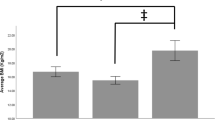Abstract
The association between vitamin D status and susceptibility to acute lower respiratory tract infection (ALRI) was studied in young Canadian children. Serum 25-hydroxyvitamin D (25(OH)D) concentrations were measured in patients aged 1–25 months admitted to hospital with uncomplicated ALRI (primarily viral bronchiolitis) as well as in healthy, similarly aged patients without a history of hospitalization for ALRI (controls). Serum 25(OH)D concentrations were similar among cases and controls (77.0 versus 77.2 nmol l−1; P=0.960), and there was no case–control difference in the prevalence of vitamin D insufficiency using two thresholds (<40 nmol l−1: 4.7 versus 1.5%, P=0.365; <80 nmol l−1: 51.6 versus 56.9%, P=0.598). Vitamin D status was not associated with the risk of hospitalization for ALRI in this population.
This is a preview of subscription content, access via your institution
Access options
Subscribe to this journal
Receive 12 print issues and online access
$259.00 per year
only $21.58 per issue
Buy this article
- Purchase on Springer Link
- Instant access to full article PDF
Prices may be subject to local taxes which are calculated during checkout
Similar content being viewed by others
References
Banerji A, Bell A, Mills EL, McDonald J, Subbarao K, Stark G et al. (2001). Lower respiratory tract infections in Inuit infants on Baffin Island. Can Med Assoc J 164, 1847–1850.
Bont L, Heijnen CJ, Kavelaars A, van Aalderen WM, Brus F, Draaisma JM et al. (2001). Local interferon-gamma levels during respiratory syncytial virus lower respiratory tract infection are associated with disease severity. J Infect Dis 184, 355–358.
Deluca HF, Cantorna MT (2001). Vitamin D: its role and uses in immunology. FASEB J 15, 2579–2585.
Hollis BW (2005). Circulating 25-hydroxyvitamin D levels indicative of vitamin D sufficiency: implications for establishing a new effective dietary intake recommendation for vitamin D. J Nutr 135, 317–322.
Muhe L, Lulseged S, Mason KE, Simoes EA (1997). Case–control study of the role of nutritional rickets in the risk of developing pneumonia in Ethiopian children. Lancet 349, 1801–1804.
Rausch-Fan X, Leutmezer F, Willheim M, Spittler A, Bohle B, Ebner C et al. (2002). Regulation of cytokine production in human peripheral blood mononuclear cells and allergen-specific Th cell clones by 1-alpha-25-dihydroxyvitamin D3. Int Arch Allergy Immunol 128, 33–41.
Roth DE, Martz P, Yeo R, Prosser C, Bell M, Jones AB (2005). Are national vitamin D guidelines sufficient to maintain adequate blood levels in children? Can J Public Health 96, 443–449.
Singh RJ, Taylor RL, Reddy GS, Grebe SK (2006). C-3 epimers can account for a significant proportion of total circulating 25-hydroxyvitamin D in infants, complicating accurate measurement and interpretation of vitamin D status. J Clin Endocrinol Metab 91, 3055–3061.
Wayse V, Yousafzai A, Mogale K, Filteau S (2004). Association of sub-clinical vitamin D deficiency with severe acute lower respiratory infection in Indian children under 5 years. Eur J Clin Nutr 58, 563–567.
Webb AR, Kline L, Holick MF (1988). Influence of season and latitude on the cutaneous synthesis of vitamin D3: exposure to winter sunlight in Boston and Edmonton will not promote vitamin D3 synthesis in human skin. J Clin Endocrinol Metab 67, 373–378.
Acknowledgements
We thank the following people for contributing to the completion of this study: the children and families who participated; Tineke Chatargoon, Tameeza Chatur, Kelly Speer (study nurses); Dr John Koller and the paediatric anaesthesiologists at the Stollery Children's Hospital; Ben Vandermeer (biostatistician, Department of Pediatrics); Andrea Patrick (administrative support); Dr Catherine Field.
Funding sources: Complementary and Alternative Research and Education (CARE) Program, Department of Pediatrics, University of Alberta; Trainee Research Grant, Department of Pediatrics, University of Alberta. Dr Vohra and Dr Roth are supported by the Canadian Institutes for Health Research and the Alberta Heritage Foundation for Medical Research.
Author information
Authors and Affiliations
Corresponding author
Additional information
Contributors: DER led the study conception, design, conduct, data analysis and manuscript preparation. ABJ, JLR and SV contributed to study design and manuscript preparation. CP performed the laboratory analyses, and contributed to study design and manuscript preparation. SV was DER's MSc supervisor during this study.
Rights and permissions
About this article
Cite this article
Roth, D., Jones, A., Prosser, C. et al. Vitamin D status is not associated with the risk of hospitalization for acute bronchiolitis in early childhood. Eur J Clin Nutr 63, 297–299 (2009). https://doi.org/10.1038/sj.ejcn.1602946
Received:
Accepted:
Published:
Issue Date:
DOI: https://doi.org/10.1038/sj.ejcn.1602946
Keywords
This article is cited by
-
Association of vitamin D with disease severity in infants with bronchiolitis
European Journal of Pediatrics (2024)
-
A randomized clinical trial to assess the effect of zinc and vitamin D supplementation in addition to hypertonic saline on treatment of acute bronchiolitis
BMC Infectious Diseases (2022)
-
Vitamin D deficiency in children with acute bronchiolitis: a prospective cross-sectional case- control study
BMC Pediatrics (2021)
-
Relationship between serum 25-hydroxyvitamin D, total antioxidant capacity and pneumonia incidence, severity and outcome in Nigerian children
The Egyptian Journal of Bronchology (2020)
-
Effect of Vitamin D Supplementation in the Prevention of Recurrent Pneumonia in Under-Five Children
The Indian Journal of Pediatrics (2019)



